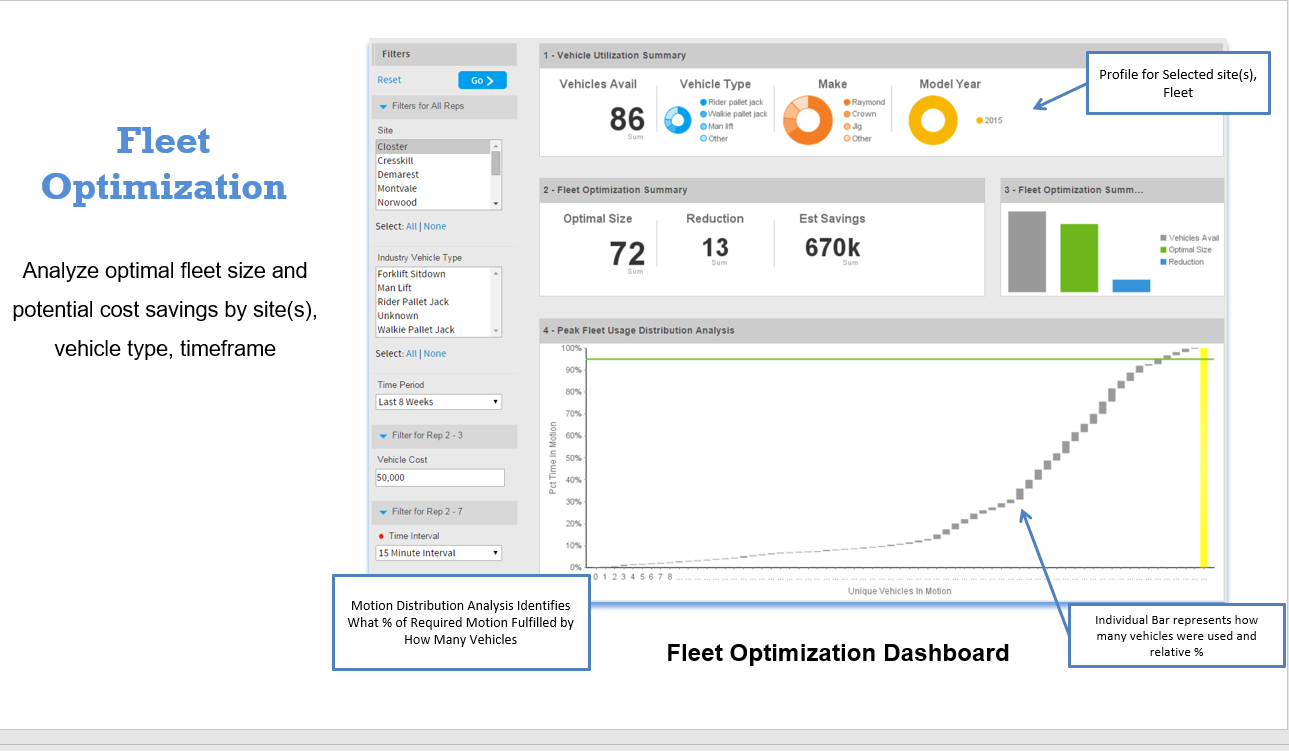Consumer expectations for fast, on-time delivery have never been higher. At the same time, an unpredictable global economy is keeping logistics managers on their toes. Warehousing operations must adapt to the constant state of change and prepare for the unexpected. Fortunately, new technologies have made adapting to fluctuating demand easier than ever.
Let’s take a look at the costs involved with MHE, how to right-size your fleet, and MHE solutions that can help streamline the process.
Many logistics managers struggle to adapt to fluctuating demand, but telematics can help bring order to the chaos. Share on XUnderstanding Costs
MHE costs represent a significant portion of operating budgets. These costs are an important variable in determining an optimal fleet size, so it’s important to have a realistic understanding that goes beyond the initial purchasing costs. These additional costs include things like maintenance, parts, labor and service agreement costs.
Some important cost-related questions to ask include:
- What is the cost-per-hour for different vehicle types or brands?
- What does the average age and repair history look like for different assets?
- What does the total cost of ownership look like for different assets?
Lift trucks typically cost between $15,000 and $30,000 each, but that’s just 20% of the lifetime cost. The other 80% of the total cost comes from maintenance over the life of the vehicle, which varies depending on usage patterns and preventative maintenance. Service agreements may streamline some of these costs but have their own nuances that can lead to overruns.
In addition to vehicle costs, lift truck operators make $14 or more per hour and supervisors can make upwards of $50,000 per year with benefits. The underutilization of employee’s time can quickly become a significant cost since people are less flexible than equipment. Meanwhile, the quality of employees’ skills set can have a big impact on efficiency and equipment lifespan.
Right Sizing Your Fleet
Determining the optimal fleet size is one of the most important parts of meeting variable demand. While too many vehicles can result in unnecessary short and long-term costs, it’s much easier to reduce materials handling equipment in use by simply parking them than it is to ramp up new equipment purchases to meet short-term demand.
Telematics can help determine the optimal fleet size by providing a detailed picture of usage patterns over time. For example, a fleet owner might realize that some lift trucks have a near 100% usage rate whereas others have a sub-50% usage rate. These patterns clearly indicate where MHE investments might be necessary to meet unexpected demand spikes.
Some important questions to ask include:
- How many lift trucks and what type are needed to meet expected demand?
- What is the maximum demand likely and what’s the best way to meet it?
- What equipment has the highest and lowest levels of utilization?
- What is the downtime associated with each vehicle type?
- How is each vehicle being utilized in the operation?
Ramping up MHE also requires a combination of sourcing, capital and time. One way to reduce some of these costs is to standardize the fleet. In addition to easier ordering and budget estimates, shippers with multiple sites can more easily redistribute equipment between sites when needed, without worrying about retraining employees on different equipment.
Finally, short-term rentals can help provide flexibility without the high cost of leasing an entire fleet. For instance, a manager may calculate that a distribution operation requires 30.4 units, but rather than purchasing 31 units, a better decision might be purchasing 30 and covering the 0.4 units with a short-term rental agreement.
MHE Solutions Can Help
Digital transformation is more than a buzzword when it comes to manufacturing and distribution. With the right data in hand, the operations team can quickly and easily make data-driven decisions that have a real impact on the bottom line. Telematics and other technologies eliminate a lot of the guesswork that can lead to inefficient operations and suboptimal profit margins.

Powerfleet IQ provides unparalleled insights into your operations. Source: Powerfleet
For instance, Powerfleet Industrial provides telematics solutions for industrial fleets of any size. In addition to equipment-level telematics, Powerfleet Industrial solutions provide unparalleled insights into your fleet to right-size operations by determining what equipment is being used to avoid over-ordering forklifts, as well as coordinate equipment across multiple locations.
Telematics also provide a variety of other benefits:
- Safety: Telematics make it easy to control access to equipment, create pre-shift checklists and instantly notify supervisors when collisions or impacts occur. In addition, managers can access aggregate statistics of safety incidents, speeds and other factors for each operator in order to protectively identify problematic behaviors.
- Compliance: Manufacturers must ensure that operators have completed the correct OSHA training and certifications before they operate equipment in order to avoid liabilities. Telematics can track these certifications and ensure that uncertified operators cannot access equipment, thereby preventing violations.
- Maintenance: Telematics can reduce maintenance costs through preventative maintenance routines. By planning ahead and proactively maintaining vehicles, businesses can reduce unexpected downtime, ensure parts are on-hand and ultimately prevent more costly disruptions from happening in the first place.
Powerfleet’s solutions can help manufacturing and warehousing operations right-size their fleets with unique insights on peak vehicle utilization, as well as provide metrics on operator activities to identify opportunities for productivity improvement and labor allocation. Two-way text messaging systems, impact sensors and other technologies also promote safety and operational benefits.
These benefits can provide a significant contribution to the bottom-line. For instance, a large food manufacturing company implemented Powerfleet’s solutions to monitor vehicle use and employee habits. The result was a 70% decrease in accidents, an 80% decrease in damage and $400,000 in cost savings per year, along with improved productivity.
The Bottom Line
Many manufacturing and warehouse operation managers struggle to adapt to fluctuating demand, but with rising expectations and uncertainty, it’s becoming more important. Fortunately, telematics and data analytics solutions can help provide unique sights to right-size fleets, optimize labor allocation and ensure that everything runs smoothly.
Contact us today to learn more!


